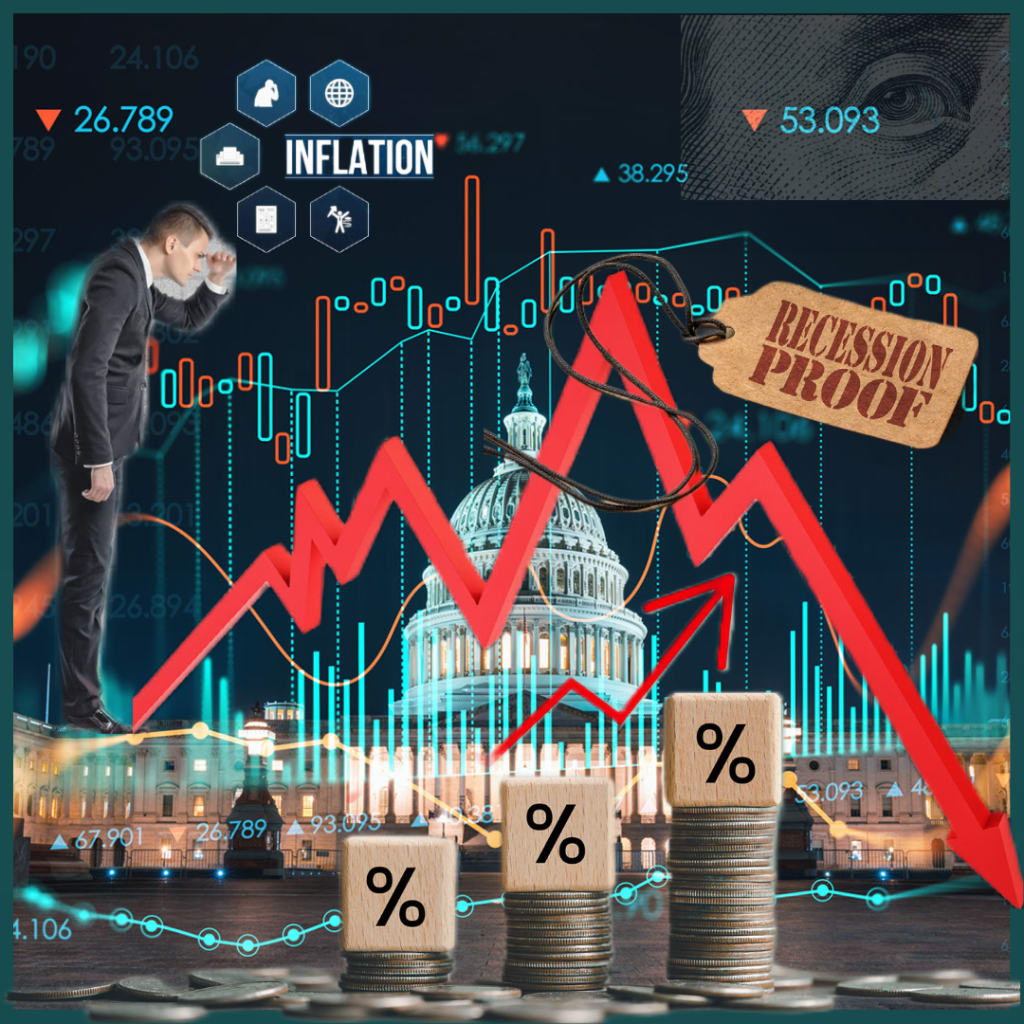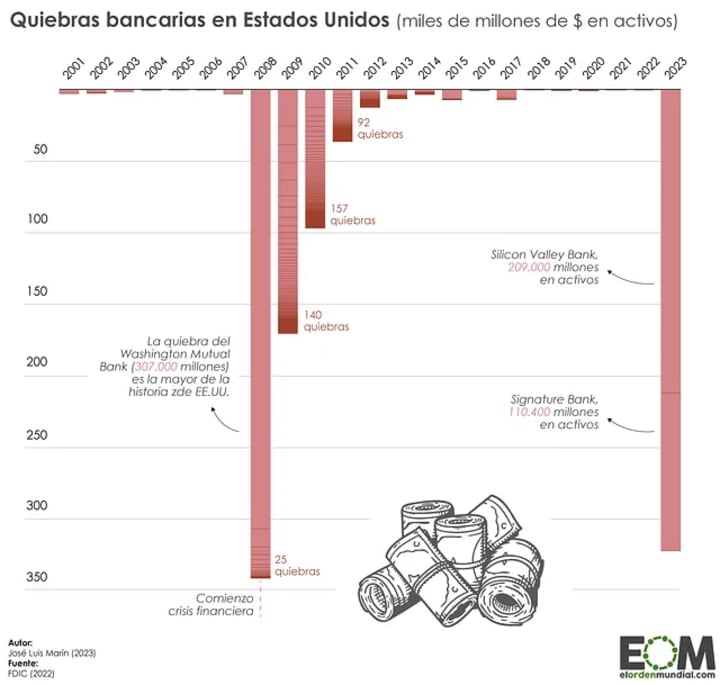The US-China economic standoff: A threat to global stability?
“With recession just around the corner, the world’s declining economic outlook has already been served up”.

“With recession just around the corner, the world’s declining economic outlook has already been served up”.
US bank failures and their impact on the global economy.
The 307 billion dollars of the 2008 bankruptcy of Lehman Brothers may turn into chump change after the failures a fortnight ago in the US of Silicone Valley Bank (209 billion USD) and Signature Bank (110.4 billion USD), and some more may be coming, at the gates of an imminent recession that nobody seems to be able to avoid. In the US alone, USD 319.4 billion has already been lost in the collapse of these two banks, and at any moment we could see the US financial system collapse again and set off a domino-like chain reaction in the rest of the world. Between the three bank failures in recent weeks, the weakness of a system in which investors do not feel safe and see their savings at risk is evident. As a result, capital withdrawals have not ceased since 2023 began.

"Taking preventive measures to avoid a possible global financial crisis”
It is true that lack of confidence in banks can be extremely dangerous and can lead to a financial crisis. Central banks are designed to provide liquidity in times of crisis and prevent cascading bankruptcies. However, as you mentioned, the problem in this crisis is not the lack of liquidity, but the valuation of assets. If assets are mispriced or inflated on banks’ balance sheets, then systemic risk is created throughout the financial system.
It is important to note that not all banks are exposed in the same way and some may be better prepared to deal with a crisis than others. It is therefore important that financial regulators and supervisors constantly monitor the financial health of banks and take preventive measures to avoid a potential crisis.
Hopefully, financial regulators will be able to adequately manage systemic risks and prevent a global financial crisis.
Trust is the feeling of being able to believe a person even when we know we would lie in their place.
Long-term financial sustainability and restoring confidence in the banking and financial system.
It is true that the current situation is worrying and there is uncertainty in the banking and financial sector. Massive money printing by central banks may have negative consequences for the economy and long-term financial stability. In addition, the quality of banks’ balance sheets is an important issue that is being closely scrutinised to avoid the spread of a potential systemic risk.
It is important to remember that history has shown us that financial crises can be unpredictable and protracted, so it is essential to take preventive measures and to be prepared for possible adverse situations. While it is true that measures have been taken to mitigate the impact of the current crisis, it is still too early to say that it is all over and that the money is safe. It is important to be alert and to maintain a cautious attitude.
The fundamental problem in the banking sector at the moment is that we have been lied to for decades, and it is hard to believe central banks, governments and the friendly media.

The European central bank has been telling us that there is no liquidity problem in Europe, but the reality is that if they were to tell us the truth, then there would be panic.
Confidence in the banking sector has suffered major setbacks in recent decades, especially after the 2008 financial crisis. Lack of transparency, over-complex financial products, opaque risk management and collusion between some banks and governments have eroded the credibility of the financial system. However, it is important to note that bank regulation and supervision have improved significantly since then, with higher capital requirements, stress tests and measures to avoid conflicts of interest.
Regarding liquidity in Europe, it is true that the European Central Bank has deployed a number of monetary policy measures to ensure financial stability in the region, including the injection of liquidity through refinancing operations and the purchase of government and private sector bonds. However, it is important to remember that liquidity is not a problem in itself, but rather a symptom of underlying problems such as solvency and asset quality. It is therefore crucial that these problems are tackled at their root to ensure the stability of the banking sector and the confidence of investors and depositors.
They are aware that shit floats, and no matter how hard they try, they know that it always ends up on the surface.
Economic uncertainty in the face of rising public debt and the difficult task of controlling inflation
It is true that inflation has been an issue of concern in recent times, with rising prices of food, energy and other goods and services. However, it is important to keep in mind that inflation is also influenced by factors such as supply and demand, productivity and the exchange rate. In addition, central banks have tools to control inflation, such as adjusting interest rates and the money supply.
In any case, it is true that public and private debt is an issue of concern worldwide, and can have serious consequences for the global economy if not properly addressed. It is important that governments and central banks work together to find long-term sustainable solutions to these problems, rather than relying on short-term measures such as money printing or bank bailouts.
With rising public debt and inflation that seems difficult to control. Central banks’ monetary policy, including money printing and lower interest rates, has created great uncertainty about the economic future. In addition, rising interest rates and bond yields have significantly affected banks’ balance sheets, leading to the need to inject liquidity and open special credit lines. All of this suggests that patches are being put in place without a clear long-term solution, which may generate instability in the future.
The history of financial crises: a consequence of the fraudulent financial system

The only possible reality, and the one we are facing, is that we have been living in a fraudulent financial system since 1913, when the Federal Reserve was created, more than 100 years ago, after several meetings in the shadows, with the 120 most important financiers in New York, as if it were a secret sect.
Among them was John Pierpoint Morgan (the founder of what is today the largest bank in the world, JP Morgan, and also of one of the giants of Wall Street, Morgan Stanley). All these meetings were the consequence of the first financial crisis of the 20th century, in 1907.
In August 1971, when Nixon definitively abandoned the gold standard, and began monetary manipulation based on “false money”, debt money, which, as always, ended in recurring financial crises, in which the banks were bailed out, and it was the taxpayers who ended up paying the price, with new taxes and price rises in basic products and services.
The uncontrolled printing of banknotes to bail out the banks is a reality right now, which we will pay for in the coming years, with a little more inflation, the continuous devaluation of currencies, while the financial institutions will once again save their families, with new bailouts and measures that only benefit a few.
If we review a little history, we observe that since 1907, 11 recessions have been suffered, plus the one that awaits us, as we are at the gates of the reports of the first quarter in the United States, which will do the honours to the collapse;
1. Year 1908 with a contraction of 3%.
2. Year 1914 with a contraction of 6.7%.
3. Years 1917–1921 with a contraction of 4.4%.
4. The years 1930–1932 with a contraction of 17.6%.
5. Year 1938 with a contraction of 0.5%.
6. Years 1945–1946 with a contraction of 15.4 %.
7. Year 1975 with a contraction of 0.8%.
8. Year 1982 with a contraction of 1.3%.
9. Year 1991 with a contraction of 0.3%.
10. Year 2009 with a contraction of 2.9 per cent.
11. Year 2020 with a contraction of 6.2 per cent.
12. The one that will befall us in 2023 or 2024.
The growing concern in the United States about the rise of China as a global economic power

To make us aware of the dimension that the economic picture of the United States is taking, it is important to note that the external debt, which is the total sum of public and private debt in 2022, stood at 30 TRILLION US dollars, which represents 132.31% of GDP, the highest debt in its entire history.
Moreover, the United States leads the world ranking of foreign debt, with more than double the figure of the second ranked China, with only 10 TRILLION, which represents 68% of its GDP.
If we add the interesting population data to all these numbers, the situation looks like this: China has more than four times the population of the United States, with its 1425 million people, compared to 340 million in the US.
I think what is happening is that Americans are concerned about China’s growth and development in recent years, as well as the fact that the United States is losing its position of global hegemony as the world’s leading power. As a result, they may be fearful about the future and what this could mean for the country.
On top of this, China’s foreign minister is openly criticising the US, accusing it of trying to suppress China from the trade landscape and making the world believe that the current economic system is zero-sum. He is also calling for trade equality and pointing out that the ideology taught in top US business schools has always advocated market liberalisation.
What is happening in the US is that they are losing confidence in their ability to compete with China in a relatively free market.
On top of that, all this is happening when in China, at its latest annual people’s assembly, the highest legislative body of the regime publicly calls for;
1. The opening of borders.
2. Trade freedom.
3. Legal certainty.
All these kinds of messages used to be sent by the Anglo-Saxon world in the past, but now it is surprising that a communist regime like China’s is openly calling for equality and freedom in international trade, while the United States advocates protectionism and trade barriers. Moreover, they have begun to create smokescreens, such as China’s nuclear threat and a possible world war, which would involve the war, energy and monetary axes.
“As can be seen, we have already addressed the initial and main issues of the current situation. It now remains to be seen how the following issues will develop and whether there will be additional difficulties in the future”.
About the Creator
Asdrubal aka LittleAsdru
"I write about finance and personal development. Author of a saga of 11 books in the works. Follow me to get advice and reflections to improve your life"
Enjoyed the story? Support the Creator.
Subscribe for free to receive all their stories in your feed. You could also pledge your support or give them a one-off tip, letting them know you appreciate their work.





Comments
There are no comments for this story
Be the first to respond and start the conversation.